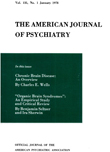THE COURSE AND OUTCOME OF PSEUDONEUROTIC SCHIZOPHRENIA
Abstract
1. This is a 5-20 year follow-up report of the course and outcome of 109 patients with pseudoneurotic schizophrenia, 60% seen initially at Psychiatric Institute and 40% in clinics or private practice.
2. About two-fifths of these patients had had previous episodes of mental illness (inpatients: 42%; ambulatory patients: 31%).
3. There appeared to be a high incidence of a life-long history of illness, though age at onset is difficult to determine. There was a striking concentration of patients in the third (50%) and fourth (25%) decades at the time of beginning treatment.
4. There was a significant incidence of subsequent hospitalization following initial contact: approximately 40% of the entire group was hospitalized 1-9 times (11% of Group 1 and 56% of Group 2).
5. Ten percent of the patients attempted suicide but only 2 patients died by suicide. There were no other deaths in this series.
6. Approximately 20% of the patients developed overt schizophrenic symptomatology at some time during the follow-up period, but half of these (10%) had a remission. Thus 10% who originally had the pseudoneurotic form of schizophrenia developed chronic forms of schizophrenia with the typical catatonic, paranoid and occasionally hebephrenic symptomatology.
7. At the time of the follow-up study, about one-third of all the patients were found to have a good, fair and poor outcome, respectively. In Group 1, 44% of the patients had a good outcome and another 40% had a fair outcome. In Group 2, one-fifth of the patients were rated as having a good outcome and 40%, a fair outcome.
8. Efforts were made to correlate outcome with various factors, ranging from family history of mental illness, through environmental vicissitudes, reactivity to stimuli, precipitating factors leading to disability, to type of treatment. There was evidence of some correlation with precipitating factor and type of treatment.
9. Forthcoming reports on the development of pseudoneurotic schizophrenia and different approaches to treatment are mentioned and the need for further, more extensive studies of this syndrome is noted.
Access content
To read the fulltext, please use one of the options below to sign in or purchase access.- Personal login
- Institutional Login
- Sign in via OpenAthens
- Register for access
-
Please login/register if you wish to pair your device and check access availability.
Not a subscriber?
PsychiatryOnline subscription options offer access to the DSM-5 library, books, journals, CME, and patient resources. This all-in-one virtual library provides psychiatrists and mental health professionals with key resources for diagnosis, treatment, research, and professional development.
Need more help? PsychiatryOnline Customer Service may be reached by emailing [email protected] or by calling 800-368-5777 (in the U.S.) or 703-907-7322 (outside the U.S.).



